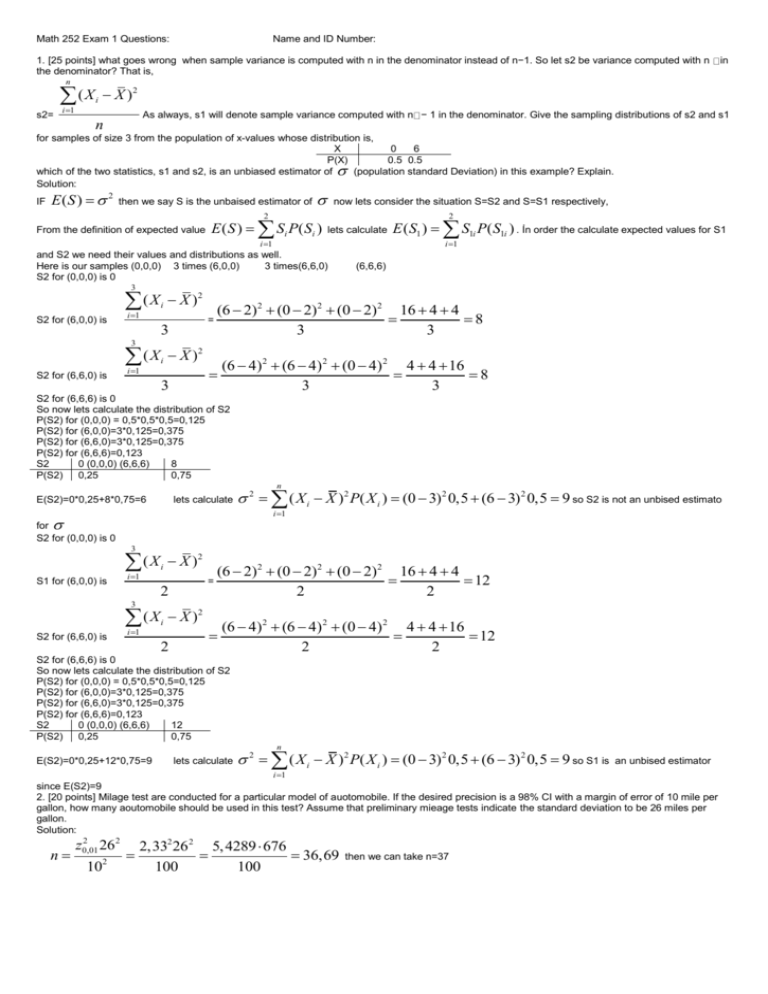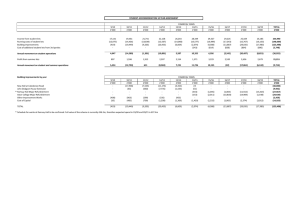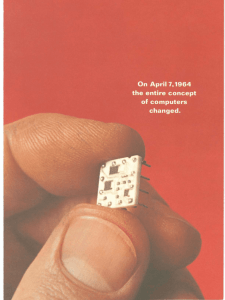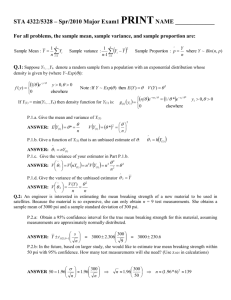Math 252 Exam 1: Statistics Questions & Solutions
advertisement

Math 252 Exam 1 Questions: Name and ID Number: 1. [25 points] what goes wrong when sample variance is computed with n in the denominator instead of n−1. So let s2 be variance computed with n the denominator? That is, n (X s2= i 1 i in X )2 As always, s1 will denote sample variance computed with n − 1 in the denominator. Give the sampling distributions of s2 and s1 n for samples of size 3 from the population of x-values whose distribution is, X 0 6 P(X) 0.5 0.5 which of the two statistics, s1 and s2, is an unbiased estimator of (population standard Deviation) in this example? Explain. Solution: IF E (S ) 2 then we say S is the unbaised estimator of now lets consider the situation S=S2 and S=S1 respectively, 2 From the definition of expected value E ( S ) Si P ( Si ) 2 lets calculate i 1 and S2 we need their values and distributions as well. Here is our samples (0,0,0) 3 times (6,0,0) 3 times(6,6,0) S2 for (0,0,0) is 0 3 (X S2 for (6,0,0) is i 1 i = 3 3 (X S2 for (6,6,0) is X )2 i 1 i i 1 (6,6,6) (6 2)2 (0 2)2 (0 2)2 16 4 4 8 3 3 X )2 3 E ( S1 ) S1i P( S1i ) . İn order the calculate expected values for S1 (6 4)2 (6 4)2 (0 4)2 4 4 16 8 3 3 S2 for (6,6,6) is 0 So now lets calculate the distribution of S2 P(S2) for (0,0,0) = 0,5*0,5*0,5=0,125 P(S2) for (6,0,0)=3*0,125=0,375 P(S2) for (6,6,0)=3*0,125=0,375 P(S2) for (6,6,6)=0,123 S2 0 (0,0,0) (6,6,6) 8 P(S2) 0,25 0,75 n E(S2)=0*0,25+8*0,75=6 lets calculate 2 ( X i X )2 P( X i ) (0 3) 2 0,5 (6 3) 2 0,5 9 so S2 is not an unbised estimato i 1 for S2 for (0,0,0) is 0 3 (X S1 for (6,0,0) is i 1 i = 2 3 (X S2 for (6,6,0) is X )2 i 1 i (6 2)2 (0 2)2 (0 2)2 16 4 4 12 2 2 X )2 2 (6 4)2 (6 4) 2 (0 4) 2 4 4 16 12 2 2 S2 for (6,6,6) is 0 So now lets calculate the distribution of S2 P(S2) for (0,0,0) = 0,5*0,5*0,5=0,125 P(S2) for (6,0,0)=3*0,125=0,375 P(S2) for (6,6,0)=3*0,125=0,375 P(S2) for (6,6,6)=0,123 S2 0 (0,0,0) (6,6,6) 12 P(S2) 0,25 0,75 n E(S2)=0*0,25+12*0,75=9 lets calculate 2 ( X i X )2 P( X i ) (0 3) 2 0,5 (6 3) 2 0,5 9 so S1 is an unbised estimator i 1 since E(S2)=9 2. [20 points] Milage test are conducted for a particular model of auotomobile. If the desired precision is a 98% CI with a margin of error of 10 mile per gallon, how many aoutomobile should be used in this test? Assume that preliminary mieage tests indicate the standard deviation to be 26 miles per gallon. Solution: n 2 z0,01 262 102 2,332 26 2 5, 4289 676 36,69 100 100 then we can take n=37 3. [20 points] A large population of voters is believed to be 45% AKP and 30% CHP. A random sample of size 350 is selected from this population. Assuming the given percentages are correct, use a normal approximation with continuity correction to estimate (a) the probability the sample will contain more than 100 CHP (b) the probability the sample will contain at most 140 AKP Solution: a) b) 100 p E ( p ) 0, 2857 E ( p ) P( p ) P( ) 350 p p P( p 100 0, 2857 E ( p ) ) P( Z ) 350 p 140 p E ( p ) 0, 4 E ( p ) ) P( ) 350 p p P( p 140 0, 4 E ( p ) ) P( Z ) 350 p P( p 100 0, 2857 0, 30 ) P( Z ) 350 0, 0244 100 0, 0143 P( p ) P( Z ) 350 0, 0244 100 P( p ) P( Z 0,5860) 350 100 P( p ) 0, 7190 350 P( p 140 0, 4 0, 45 ) P( Z ) 350 0, 0187 140 0, 05 P( p ) P( Z ) 350 0, 0265 140 P( p ) P ( Z 1,88) 350 140 P( p ) 0, 0239 350 P( p 4. [20 points] The height of the population (the size of the population is 2000) in a town is normally distributed with mean 1,65meter. A random sample of size 17 is selected from this population and sample sd 0,1 meter. What is the probabability that the sample mean is between 1,55 meter and 1,80 meters? P (1,55 X 1,80) P ( P (1,55 X 1,80) P ( 1,55 E ( X ) X 1,55 E ( X ) X X E( X ) X t / 2, 1,80 E ( X ) X 1,80 E ( X ) X ) ) 1,55 1,65 1,80 1,65 t / 2, ) s/ n s/ n 0,1 0,15 P (1,55 X 1,80) P ( t / 2, ) 0,1/ 17 20 / 21 0,15 P (1,55 X 1,80) P ( 17 t / 2,17 1 ) 0,1/ 17 P (1,55 X 1,80) P ( P (1,55 X 1,80) P ( 4,123 t / 2,16 6,1848) P (1,55 X 1,80) 1 5. [25 points] The National Center for Education Statistics reported that 47% of college student work to pay for tuition and living expenses. Assume that a sample of 450 collage students was used in this study. a) Provide a 95% CI for the population propotion of college students who work to pay for tuition and living expenses. b) What happens to the margin of error as the confidence is increased from 95% to 99%? Solution: a) 0, 47(1 0, 47) ) 450 ( P Z 0,025 P ) (0, 47 1, 96 0, 0235) ( P Z 0,025 P ) (0, 47 1, 96 ( P Z 0,025 P ) (0, 47 0, 04) ( P Z 0,025 P ) (0.43, 0.51) b) 0, 47(1 0, 47) ) 450 ( P Z 0,005 P ) (0, 47 2,58 0,0235) ( P Z 0,005 P ) (0, 47 2,58 ( P Z 0,005 P ) (0, 47 0,06) ( P Z 0,005 P ) (0.41,0.53) As we see margin of error increased from 0,04 to 0,06 when confidence is increased from 95% to 99%











